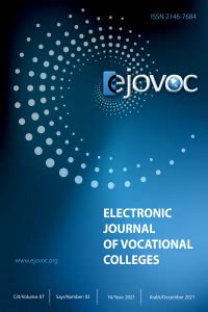EVALUATION OF EINKORN BRAN AS SUBSTRATE FOR SYNTHESIS OF ALPHA AMYLASE FROM PENICILLIUM HERQUEI IN SOLID STATE FERMENTATION PROCESS
Solid State Fermentation (SSF) is a process defined as microorganisms
growing on a solid substrate in the absence of water. It is similar to natural
microbial processes such as composting and ensiling. This technique has been
known for a long time and is used widely in the Far East. It can be also used in industrial
applications such as Roquefort cheese, antibiotics, organic acids, plant
growing agents, food additive materials and enzyme production. In this study,
α-amylase production was done in SSF process from Penicillium herquei. Agricultural by-products such as wheat (Triticum aestivum L.) bran and einkorn (Triticum monococcum L.) bran have been
tested for enzyme production, individually and as a mixture. The highest enzyme
activity (602 U/gds±5.6) was recorded in the SSF process where einkorn bran was
used as the substrate. The process parameters such as initial moisture level and
substrate amounts were optimized to determine their effects on enzyme synthesis
from P. herquei.
Anahtar Kelimeler:
Solid State Fermentation, einkorn, Penicillium herquei, amylase
EVALUATION OF EINKORN BRAN AS SUBSTRATE FOR SYNTHESIS OF ALPHA AMYLASE FROM PENICILLIUM HERQUEI IN SOLID STATE FERMENTATION PROCESS
Solid State Fermentation (SSF) is a process defined as microorganisms
growing on a solid substrate in the absence of water. It is similar to natural
microbial processes such as composting and ensiling. This technique has been
known for a long time and is used widely in the Far East. It can be also used in industrial
applications such as Roquefort cheese, antibiotics, organic acids, plant
growing agents, food additive materials and enzyme production. In this study,
α-amylase production was done in SSF process from Penicillium herquei. Agricultural by-products such as wheat (Triticum aestivum L.) bran and einkorn (Triticum monococcum L.) bran have been
tested for enzyme production, individually and as a mixture. The highest enzyme
activity (602 U/gds±5.6) was recorded in the SSF process where einkorn bran was
used as the substrate. The process parameters such as initial moisture level and
substrate amounts were optimized to determine their effects on enzyme synthesis
from P. herquei.
___
- Abou-Zeid A.M., 1997, Production, purification and characterization of an extra cellular amylase enzyme isolated from Aspergillus flavus, Microbios, 89, 55–66. Balkan B., Ertan F., 2007, Production of α-amylase from Penicillium chrysogenum under solid state fermentation by using some agricultural by products, Food Technology and Biotechnology, 45 (4), 439-442. Baysal Z., Uyar F., Aytekin Ç., 2003, Solid state fermentation for production of α-amylase by a thermotolerant Bacillus subtilis from hot-spring water, Process Biochemistry, 38, 1665-1668. Crabb W.D., Mitchinson C., 1997, Enzymes involved in the processing of starch to sugars, Trends Biotechnology, No. 15, 349-352. Cowan D., 1996, Industrial enzyme technology, TIBTECH, No. 14, 177-178. Ellaiah P., Adinarayana K., Bhavani Y., Padmaja P., Srinivasulu B., 2002, Optimization of process parameters for Glucoamylase production under solid state fermentation by a newly isolated Aspergillus species, Process Biochemistry, 38, 615-620. Francis F., Sabu A., Nampoothiri K. M., Szakacs G., Pandey A., 2002, Synthesis of α-amylase by Aspergillus oryzae in solid state fermentation, Journal of Basic Microbiology, 42, 320-326. Hagihara H., Igarashi K., Hayashi Y., Endo K., Ikawa-Kitayama K., Ozaki K., Kawai S., Ho S., 2001, Novel a-amylase that is highly resistant to chelating reagents and chemical oxidants from the alkaliphilic Bacillus isolate KSM.K.38, Appl. Environ. Microbiol. 67, 1744–1750. Haq I., Ashraf H., Qadeer M.A., Iqbal J., 2003, Production of alpha-amylase by Bacillus licheniformis using an economical medium, Bioresour. Technol. 87, 57–61. Hölker U., Höfer M., Lenz J., 2004, Biotechnological advantages of laboratoryscale solid-state fermentation with fungi, Applied Microbiology and Biotechnology, 64, 175-186. https://kastamonu.tarim.gov.tr/Belgeler/, 10 September 2018 also reached. Nigam P., Singh D., 1994, Solid-state (substrate) fermentation systems and their applications in biotechnology, Journal of Basic Microbiology, 34, 405-423. Pandey A., Selvakumar P., Soccol C.R. and Nigam P., 1999, Solid state fermentation for the production of industrial enzymes, Bioresource Technology, 77, 149-162. Perez-Guerra N., Torrado- Agrasar A., Lopez-Macias C. and Pastrana L., 2003, Main characteristics and applications of solid substrate fermentation, Electronic Journal of Environmental Agricultural and Food Chemistry, No.2(3). Raimbault M., 1998, General and microbiological aspects of solid substrate fermentation, Electronic Journal of Biotechnology, 3, 1-15. Ramachandran S., Patel A.K., Nampoothiri K.M., Chandran S., Szakacs G., Soccol C.R., Pandey A., 2004, Alpha amylase from a fungal culture grown on oil cakes and its properties, Braz. Arch. Biol. Technol. 47, 309–317.
- ISSN: 2146-7684
- Yayın Aralığı: Yılda 2 Sayı
- Başlangıç: 2011
- Yayıncı: Kırklareli Üniversitesi
Sayıdaki Diğer Makaleler
Makbule Hilal MÜTEVELLİ, Semih ERGİN
NESNELERİN İNTERNETİ TABANLI BİR SERA TAKİP SİSTEMİ
Kenan BAYSAL, Murat Olcay Özcan, Fatma Funda ÖZDÜVEN, Burak BEYNEK
ECONOMIC DETERMINANT OF SELF EMPLOYMENT IN A DEVELOPING NATION: THE NIGERIA EXPERIENCE
ANALYSIS OF SELLECTED GRID CODE SPECIFICATIONS FOR OFF-SHORE WIND FARM
MİMARİYİ SES İLE TASARLAMAK ÜZERİNE ÖĞRENCİ İZLENİMLERİ
Hamidi AHMED, Zidour MOHAMED, Sadoune MOHAMED
Tawfiq BOUDJENANE, Nassira OBAKHTİ, Mohamed BENLEBAD, Abedletif HABİ
ADDITIVE MANUFACTURING (3D PRINTING) APPLICATIONS IN AUTOMOTIVE SECTOR
